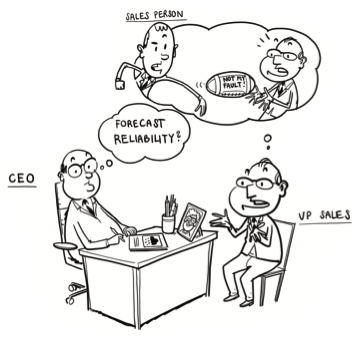 We talk about customers having a Pain Point, well I received this letter recently from a Sales Manager who very eloquently expressed his own pain. When I tell you he was contacting me because of problems with sales forecasting I know some of you will be wincing already. This is what he wrote.
We talk about customers having a Pain Point, well I received this letter recently from a Sales Manager who very eloquently expressed his own pain. When I tell you he was contacting me because of problems with sales forecasting I know some of you will be wincing already. This is what he wrote.
‘Our key issue is: how to make our overall sales results more predictable. We have failed to achieve our sales targets for four years and this has a potentially corrosive impact on the motivation of staff and the company’s wider overall performance.
There has been a tendency historically for the company to optimistically over-estimate and then under deliver in the area of sales achievement. We have also tended to be too dependent on a limited number of very large deals. When any one or two of these deals is deferred or cancelled the company’s sales and EBIT performance for the year is then immediately and irrevocably placed at risk. Addressing this issue is a top priority.’
We were able to help this company on a whole series of issues that will improve not only sales forecasting but overall sales.
Why does forecast reliability matter so much?
Well investors expect reliable figures from the CEO. Production and implementation teams need to plan resources and the CFO needs to plan cash flow. Everyone from external investors, the C-suite, production and purchasing can be affected if planning is based on unreliable sales forecasts. So sales forecast accuracy does matter.
In reality, we are not talking about slight variations. According to research I have seen, the average sales forecast is out by 50%! Sales teams on average only close half the deals (by value) that they have committed for the quarter. Even more worrying, the Sales Managers who are least good at forecasting are getting worse.
What can you do?
In our experience – and this is working with the client who wrote the letter at the top of this article – there are 5 things you as a Sales Leader can do:
-
Better understand the customer’s buying cycle
-
Use the tools in your Sales Process better
-
Concentrate training and coaching on the early stages of the Sales Process
-
Concentrate on generating better quality leads
-
Learn more from wins
Missing or incorrect information about the customer buying cycle
The problem is that few if any customers will volunteer to take you through their buying cycle. Many don’t even have a formal, documented process so they may not even know where they are themselves! But you need to understand where they are to predict the timing of the purchase decision.
What do I mean by a buying cycle? Well, briefly, these are the terms I use to describe them you may have others.
-
Not in the market
-
Pain identified
-
Problem definition
-
Solution exploration
-
Evaluation
-
Solution recommended
-
Solution signed off
-
Implementation
There are 3 ways to identify where they are; their questions, your questions and learning from previous wins.
In your first contacts with a prospect, when you speak to them they will ask you questions. For instance, if they are asking: ‘What are other people doing? Are there any new developments I should be aware of?’ they are probably in stage 1. If they are asking about your ability to deliver a solution, costs and time scales there is a good chance they are in stage 5.
Once you start working with a prospect you can get a clearer picture of what stage they have reached. The most important thing is to develop a Coach who can help you with this. I have written more about the role of the Coach here. Once you have done this you can get a clearer picture of what sort of pace the buying process is moving at, if that changes, the key influences and anything else you need to help you move the process forward in the right way.
If you have worked with this customer before you should have done a win interview, more about this later.
Using Sales Process tools effectively
An Opportunity Review, or Opportunity Pit Stop as we prefer to call them, is the time when a manager can really understand what is going on. As a manager you need to know the truth and provide support to eliminate issues. Use the knowledge gained in the Pit Stop to build a realistic worst case scenario – how does your forecast look if the biggest opportunities that may not come through don’t come through?
The other tools you can get Sales People to use are a Mutually Agreed Action Plan and a Deal One Pager. These are customer-facing documents; the MAAP is a collaborative tool that reveals a lot about the customer’s buying process and timing. The Deal One Pager is a great help to the customer to accelerate internal selling and handy for the Sales Manager to get an overview of the deal.
Coach early, coach effectively
It’s easier to forecast sales if you get things right at the start of the Sales Process rather than try and fix them at the end. Many Sales Managers concentrate on the Closing Phase when their time would be better spent at the Needs Assessment phase.
While working with an international software company recently, we found a high correlation between forecasted deals that slipped or were lost and the lack of a formal Needs Assessment Document. The action point was clear - managers should proactively coach for and attend Needs Assessment meetings. By doing this they can help to shift the customer from what they think they want to what they really need, secure a formal sign-off of what needs to be improved and the quantification of benefits. This not only helps to define the problem but also helps to gauge the degree of urgency.
Better leads = better forecasts
In my experience, if a team is under pressure to deliver results, especially after a bad month or two, they will clutch at straws wasting time and resources chasing leads they should not bother which in turn makes forecasts even less reliable.
It’s far better to concentrate the resources of your team and marketing on generating better quality leads and more of them. A sales pipeline made up of good quality, well validated opportunities makes forecasting far more accurate and in the long term you will win more business from fewer resources.
Win interviews help you gain insight
I have spoken a lot about the value of loss interviews, but the thing you won’t get from a loss interview is an insight into the buying process. But a win interview allows you to discuss the buying process with your new customer and learn a great deal. This is intelligence that will be vital next time you sell to the same organisation and it can cast light on other organisations buying process.
I ran a workshop recently and one participant shared his knowledge of a key customers internal approval process and it was clearly the best bit of the whole workshop for a lot of people.
Forecasting is difficult and nobody gets it right all the time. But there are things you can do to improve accuracy. Your sales team will be far more credible in the organisation if you address the issue effectively.
Ask yourself
-
Do you concentrate enough on generating quality leads?
-
Do you validate where the prospect is in their buying process?
-
Do you use win interviews to gain intelligence about the buying cycle?
Enjoyed this blogpost? Find out more about the sales process and using the tools effectively - Download our eBook:

